Sunday, March 31, 2024
Lucknow Man Strangles Wife, Then Kills His Eyewitness Children
Man's Body Found In Septic Tank In Delhi, Police Suspect Murder
Nagpur Man Steals To Buy New Mobile Phones, Arrested: Cops
Sunita Kejriwal Reads Out Jailed Husband's 6 "Guarantees" Ahead Of Polls
"Came From Mars?": Man Takes Uber Auto For Rs 62, Gets Rs 7.66 Crore Bill
Saturday, March 30, 2024
INDIA Bloc Leaders Who Will Attend AAP's Mega Rally In Delhi Today
Friday, March 29, 2024
6 new Reddit Ads Manager features to simplify campaign creation and tracking
Reddit Ads Manager has been updated to simplify the process of creating and tracking campaigns more efficiently.
The platform now offers six new automated features designed to provide advertisers with easy access to creative best practices.
Why we care. These updates offer advertisers simpler ways to build campaigns and receive creative support, which could be particularly beneficial for small and medium-sized businesses (SMBs) with limited resources.
Smart headlines. This new tool automatically generates a variety of ad copy headlines tailored to Reddit’s unique audience. To utilize it, advertisers only need to input their website URL.
Creative asset cropper. This new tool enables advertisers to crop images to fit Reddit’s ad format specifications, making the upload process simpler.
Lowest cost automated bidding strategy. This new tool is designed to help advertisers maximize campaign results within their budgets by automatically setting an ad cost amount. Initially used by advertisers focusing on Traffic and Simple Create, it’s now available for those with Conversions and Installs objectives.
Average daily budgets. This update automates advertisers’ daily budgets to align with their total spend for the week, reducing the need for manual adjustments to accommodate spending fluctuations.
Updated campaign management. Reddit has enhanced its duplication and bulk edit functionalities to now allow advertisers to duplicate existing campaigns, ad groups, or ads, and use them as a blueprint for new ones. Additionally, the bulk edit tool features a new user interface, facilitating faster edits and optimizations for campaigns.
Reporting improvements to Reddit Dashboard. Reddit has updated its Dashboard UI to enhance clarity for advertisers tracking their campaign performance in real time. The updates offer improved usability, new graphs displaying performance metrics, and additional report filtering options for customized tracking.
What Reddit is saying. Reddit’s EVP of Business Marketing and Growth, Jim Squires, said in a statement:
- “Every campaign on Reddit is unique, and we’re focused on serving our advertisers’ needs while providing best practices on creative, strategy, and campaign management,”
- “Through automation, our aim is to make it easy to create the best and most relevant ad experiences for advertisers and users alike. Smart Headlines, for example, is an intuitive tool that all Reddit advertisers can leverage to effectively connect with their audience.”
from Search Engine Land https://ift.tt/b90cXRK
via https://ift.tt/Hs7w3Ql https://ift.tt/b90cXRK
Thursday, March 28, 2024
Pinterest shares algorithm insights as it shifts focus to non-engagement signals
Pinterest provided insights into how its algorithm works while warning of the risks of overreliance on user engagement. The platform emphasized that excessive reliance on engagement to rank content can result in a negative user experience, and proposed non-engagement signals as a solution.
To encourage other companies to follow suit and contribute to “building a more inspired Internet,” Pinterest published a new document titled ‘Field Guide to Non-Engagement Signals’.
Why we care. By having a better understanding of how Pinterest’s algorithm works, brands can identify what metrics they should prioritize in order to secure more visibility for their content.
What are non-engagement signals? Non-engagement signals are generated from two primary sources:
- In-app surveys: These give users have the opportunity to provide direct feedback about the platform. For instance, Pinterest may conduct surveys within the app to gather user insights.
- Independent assessments of content quality: This tends to be generated from manual labeling.
In addition to balancing engagement signals in content ranking, non-engagement signals enable Pinterest to align with its values. For example, Pinterest’s commitment to inclusivity is supported by non-engagement signals. When users specify preferences regarding body type, hair pattern, or skin tone in their feed, Pinterest can prioritize relevant content accordingly.
Field guide. Pinterest teamed up with UC Berkeley and the Integrity Institute to create the Field Guide to Non-Engagement Signals in a bid to help platforms create a better user experiences over time. Pinterest noted that the purpose of the guide is simply to help platforms make informed decisions when it comes to utilizing Non-Engagement Signals, as opposed to tell them what to do.
Key takeaways. The field guide, which is based on practical industry knowledge, offers several practical applications for product development, including:
- How to tune for emotional well-being.
- Using Generative AI to scale content quality signals.
- Improving user retention.
What Pinterest is saying. Leif Sigerson, Pinterest Sr. Data Scientist, and Wendy Matheny, Pinterest Sr. Lead Public Policy Manager, said in a blog post:
- “User engagement is a critical signal used by Pinterest and other online platforms to determine which content to show users. However, it is widely known that optimizing purely for user engagement can surface content that is low-quality (e.g., clickbait), or even harmful.”
- “Our CEO, Bill Ready, explained that if we’re not careful, content ranking can surface the ‘car crash we can’t look away from’, On the other hand, if you ask somebody after they saw the crash, ‘you want to see another one?’’ the vast majority of people will say ‘Goodness no’.”
- “Non-Engagement Signals are a critical component to ensure we don’t optimize for ‘the car crash we can’t look away from.'”
Deep dive. Read Pinterest’s blog in full or download a PDF copy of the field guide for more information.
from Search Engine Land https://ift.tt/OtpD0qB
via https://ift.tt/cDNfF1Y https://ift.tt/OtpD0qB
Man Lures Three-Year-Old Girl With Candies Then Rapes Her: Delhi Police
Wednesday, March 27, 2024
Delhi Records Warmest Day Of Year So Far At 37 Degrees Celsius
Hotel Owner Dies By Suicide In Bhopal, Was Depressed: Cops
Tuesday, March 26, 2024
Delhi Assembly Session Today, 1st Since Arvind Kejriwal's Arrest
UP School Principal Arrested For Sexually Abusing Students: Cops
Cop Injured In 'Accidental Firing' At Police Post In Ram Temple Complex
LinkedIn Ads launches dynamic UTMs for campaign tracking
LinkedIn is launching a new solution for monitoring campaign performance without third-party cookies.
Dynamic UTMs, which will be available to all users globally by the end of March, simplify adding custom tracking elements to campaign URLs, improving tracking accuracy.
Previously, marketers had to manually create UTM parameters for their campaigns, but with Dynamic UTMs, this process is automated.
What are UTMs? UTM parameters, short for Urchin Tracking Module parameters, are small pieces of text added to the end of your ad’s destination URL that can help you track information about the source of an ad click. For example, you can add tracking parameters to help measure how many clicks to your website were from a specific campaign or placement.
Why we care. UTMs are essential for marketers to grasp a campaign’s performance, especially in a privacy-focused landscape, as they don’t rely on third-party cookies or IP addresses for ad measurement. However, creating them manually can be time-consuming, inefficient and prone to errors. This solution looks address these challenges.
Supported URL tracking parameters. You can add both static and dynamic URL parameters to your campaigns (see the screenshot below). When adding a URL parameter, you’ll need to add both the parameter key and value.
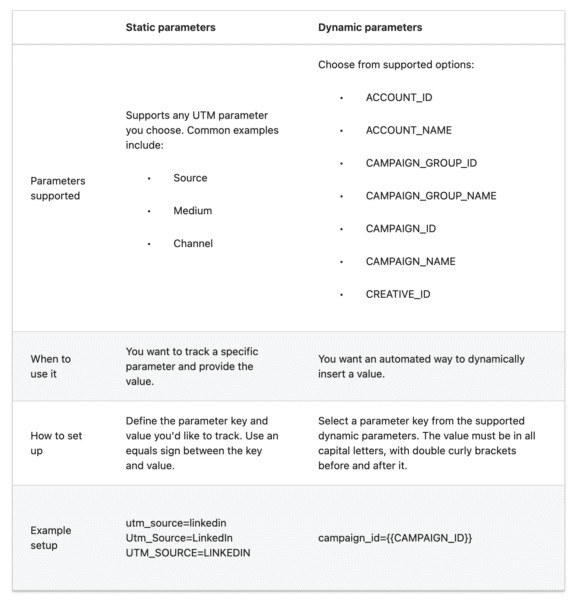
Deep dive. Read LinkedIn’s announcement in full for more information.
from Search Engine Land https://ift.tt/7Nwxdy4
via https://ift.tt/62gexd0 https://ift.tt/7Nwxdy4
Monday, March 25, 2024
Fire Breaks Out At Corporate Park In Mumbai, None Hurt
Delhi Metro Shuts Gates Of 3 Stations Over AAP Protests
7-Year-Old Boy Killed After Car Hits Motorcycle In Noida: Police
How to benchmark PPC competitors: The definitive guide
Prior to launching any PPC campaign, you must benchmark your competitors. This vital step will help you identify strategic best practices and set your account apart – which can improve performance dramatically.
On a more tactical level, benchmarking allows you to:
- Gather audience insights to better allocate budget.
- Assess ad quality and relevance to spark higher creativity levels.
- Identify ideal customer journeys that will improve conversion rates.
- Find common ground for comparison instead of using results from generic studies.
In this article, I will explore how to benchmark PPC competitors using accurate and reliable data sources.
1. Identify your PPC competitors
While in-house marketers know direct competitors and distributors by heart, online competitors may vary from real-life competitors. In practice, this means that you can identify other competitors as follows:
- Direct competitors: They offer nearly identical products or services. They are your most obvious competitors.
- Indirect competitors: They do not offer the same products or services but target the same audience. Think sleeping app vs. mattresses. Depending on the audience, they can be harmful or a mild nuisance.
- Distributors, affiliates and comparison sites: They promote your products and your competitors’. Half competitors, half partners: you should not ignore them.
Google Ads Auction Insights report
To identify indirect competitors, I recommend you start by using Google Ads Auction Insights report. It is reliable and free (as long as you run a Search/Shopping campaign).
Select a keyword (preferably exact or phrase match type) and note competitors with high Impression Shares.
In the below table, you’ll find an example for mattresses. Notice direct, indirect and distributor competitors:

Legend:
 – Direct competitors
– Direct competitors – Indirect competitors:
– Indirect competitors: – Distributors, affiliates, comparison sites
– Distributors, affiliates, comparison sites
As you can see, there is quite a lot of pressure from distributors, so you may want to review your strategy based on your unit economics.
Does it even make sense to advertise on such a keyword? Or is the share of revenue given to distributors so high you’d rather compete with them for that click?
On the other hand, there’s only one indirect competitor. While it’s not obvious if their audiences are qualified (they “only” sell bed linen), you could still experiment and potentially find untapped audiences.
Organic results
While you want to focus on PPC competitors, you can always learn interesting bits and pieces from competitors who do not face you in terms of PPC results. So, I recommend you scan Google’s top organic results for the same keyword.
To do so, you can either Google that directly or use a dedicated tool such as Ahrefs or Semrush.

At this step, your goal is to:
- List competitors with the most prominent reach: do they have high traffic for that keyword?
- List themes (SERP copy) that don’t get much traffic.
With those two groups of competitors (and already a bunch of useful information), you can move on to the next phase: stealing their best ideas.
2. Competitors’ PPC ad analysis
While there are plenty of PPC spying tools out there (SpyFu being the most popular I believe), I recommend using 100% reliable data sources: the ad networks’ ads libraries.
Ad libraries
You could stop at Google Ads Transparency Center. But I strongly recommend using other libraries such as:
- Meta Ads library.
- TikTok Ads library.
- Even LinkedIn’s (visit your competitor’s company page, then click Posts > Ads).
At this step, all you want is to populate a table with your competitors and all the different ad networks you can think of. This will give you a good idea of their reach, which strongly correlates with their ad budget.
Ultimately, you don’t want to compare yourself to a behemoth. That data can help show your CEO that, maybe, they should stop comparing your small company’s results to those of much bigger competitors.
Channels and audiences
Once you find a competitor on several ad networks, notice the overall audience they address on that network. Sometimes, there won’t be any difference, but if you’re lucky, you can learn best practices without spending any money.
In the below example, Welcome to the Jungle is a job search engine. Notice how LinkedIn ads are aimed at recruiting companies and YouTube ads are aimed at recruiting job candidates.
If you were to target one or the other audience, that would be quite a best practice to steal!


in France, March 2024. Video ads read: “Choose the company that fits you.”
Ad formats
Next stop: ad formats. Those will provide two very interesting pieces of information: the ad channel and the ad format itself.
For example, in the screenshot below of Google Ads Transparency Center, you’ll notice Samsung advertises on Search, Display, and Shopping channels.
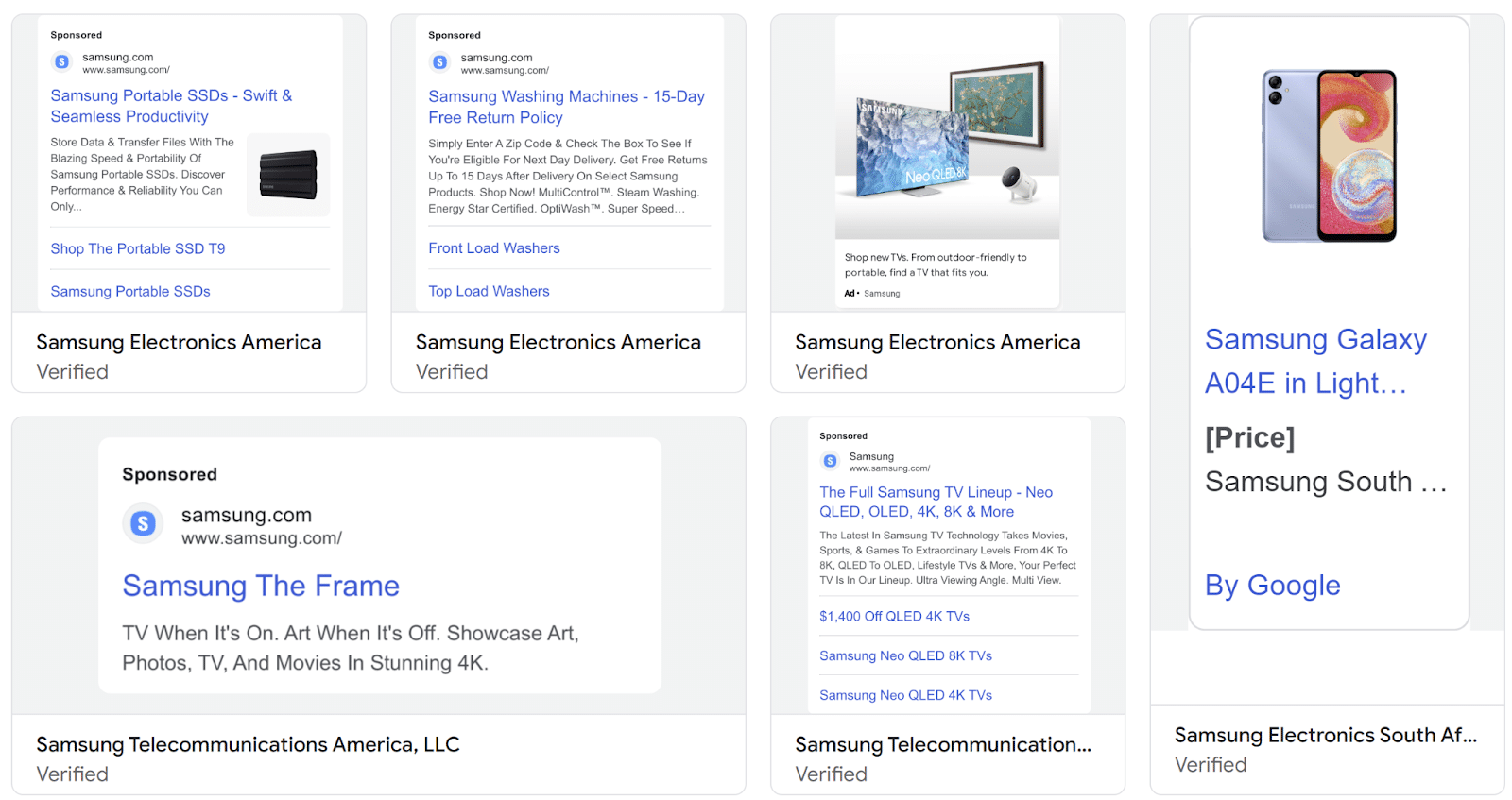
You can have a rough idea of their budget by looking at those two dimensions (ad channel and ad format). For example, producing video ads is often very costly. In the case of Welcome to the Jungle, there are tons of videos (see screenshot above).
Guess what their media budget looks like?
Comparatively speaking, Google Ads transparency center only shows text ads for Great Place to Work. While it’s not very scientific, it’s safe to say that such an ad format is cheaper to produce – which hints at a lower media budget.
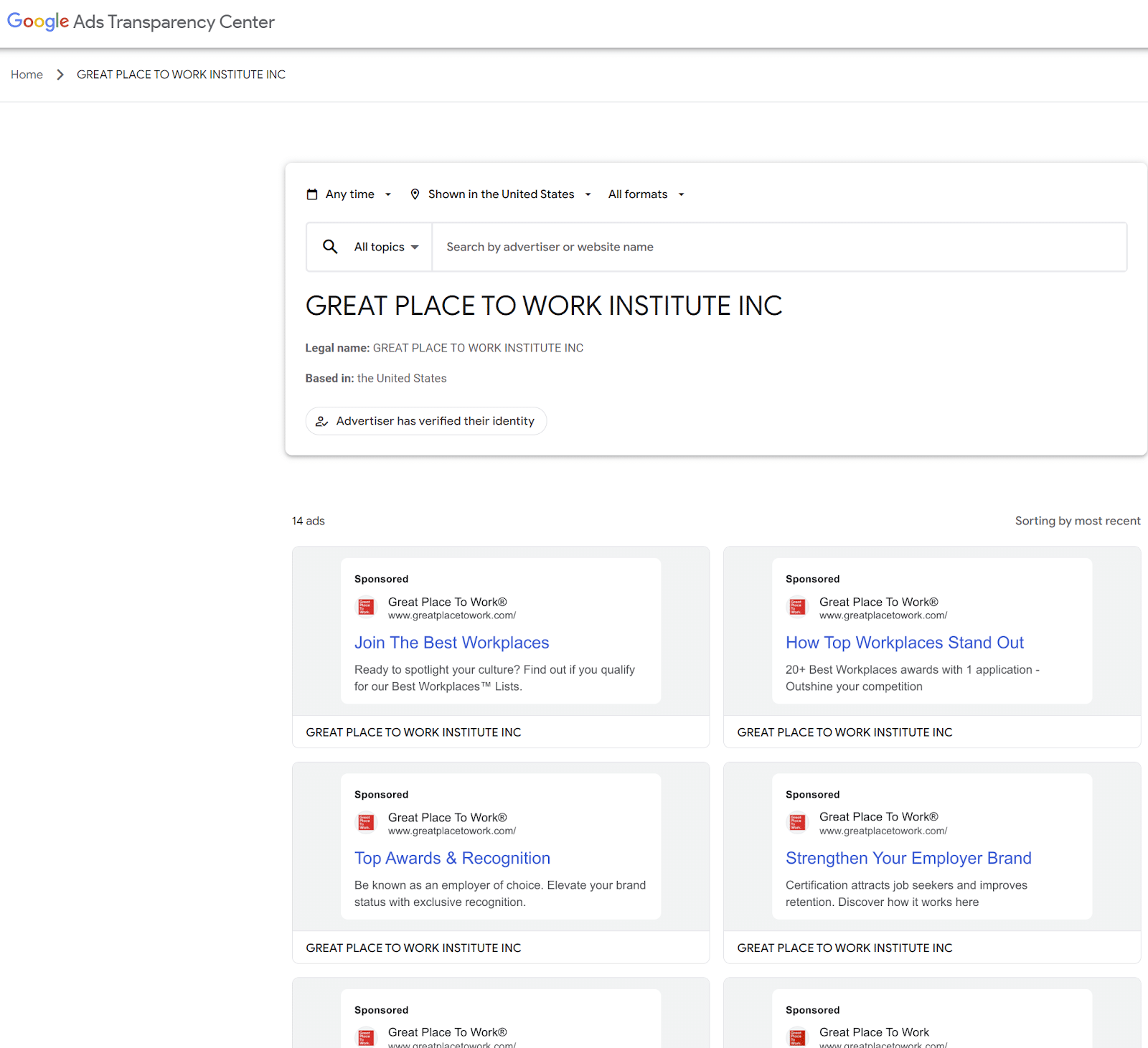
Ad copy and creative
Final ad library stop: You want to note ad copy and creative items that stand out. Those can vary a lot depending on your industry, but here’s a list to get you started:
- Unique selling propositions (USPs): Unique technology, superior service, features, etc.
- Pricing: Discounts, promo codes, sales, etc.
- Emotion: Fear of missing out (FOMO), security, etc.
- Risk-free: Money-back, free trials, warranties, etc.
- Credibility/authority: Testimonials, user reviews, expert endorsements, awards, certifications, etc.
- Urgency/scarcity: Limited-time offers, stock, countdown timers, etc.
- Brand voice: Tone, style, personality, etc.
Again, you can use ad libraries to identify top-recurring copy and creative, which likely indicate top-performing assets.
And if they test several themes, it’s a good idea to look at those ad libraries regularly. Themes that disappear are most probably low performers. You then have two options:
- If you feel you’re a better match for that claim, then experiment with it.
- If you feel you’re not better equipped to answer that need, then discard it altogether.
In the below examples, it’s interesting to note that Suunto makes a powerful claim by linking superior battery life to pioneering since 1936. This builds authority and makes Garmin’s ad copy look bland.


3. Competitor customer journey analysis
Landing page types
Using Meta Ads library, you can click through to your competitors’ landing pages, using the ad’s call-to-action, as if you were on Facebook or Instagram.
For example, the below ad redirects to this landing page, which is most probably optimal: that’s the exact product page that matches the ad creative.

Conversely, the below ad redirects to a collection page. Is that best practice? Does it depend on product families?
Categorizing competitor landing pages by type (home, collection, product, etc.), you can answer those questions easily.

Landing page experience
Below are some items to note:
- Pop-ups: In the above Banana Republic example, we have not one but two pricing-related messages. Clearly, they’re discounting hard. Should you match that?
- Format: In the above Banana Republic example, the landing page is clearly a mobile-first page. Which is not the case for Salomon. Who do you think gets higher conversion rates?
- Load time: Look into PageSpeed Insights, which will provide reliable comparison metrics with your own page:

Funnel analysis
If you can, go to the end of the purchase experience (this is tougher for B2B competitors, but more often than not, you can sign up for a demo, free trial, etc., which is already very interesting).
What you want to pay special attention to are:
- Callouts: In the example below, they use FOMO and free shipping items. Notice how that ties in with the ad theme and landing page pop-ups.
- Cross-sell/upsell: Are they showcasing specific products? And could you use that to your own advantage? For example, can you bundle your products in a way that outsmarts competitors?

Landing page content analysis
On top of the above, I strongly recommend analyzing the overall content. While you could theoretically use SEO tools such as Ahrefs or Semrush, I often found that real-life ad landing pages aren’t indexed by them. It’s likely because those pages change too often and have relatively low SEO impact.
This means you need to revert to manual analysis. To do so, you can simply scan the page and identify your competitor’s unique value proposition. You should identify their market positioning (and how you can optimize your own to be distinct and appealing).
While it’s all fine and dandy to do so for a few landing pages, if you need to do that at scale or at least a dozen competitors, it quickly becomes cumbersome. If that’s the case, then I’d suggest extracting the landing page words using some sort of scraping technique.
An easy way to do so is to use the relatively new Excel’s Power Query web connector. If you’re not familiar with this, I strongly recommend Leila Gharani’s video, which does an excellent job of outlining what it is and how to use it.
Once that’s done, you can use Excel to identify top recurring keywords. If you’re unfamiliar with such techniques, you can simply use ChatGPT to come up with the right VBA.
Dig deeper: 5 tips for creating a high-converting PPC landing page
Further analysis
Looking outside of PPC landing pages will help provide additional insights you could leverage in your own campaigns. Here are some pieces of advice to go the extra mile:
- Sign up for your competitors’ newsletters and other email/loyalty programs to identify recurring themes, their sequence and frequency, etc.
- Visit their social media accounts and note their latest content theme, posting frequency, engagement levels and how they integrate with their PPC ads.
- Use Ahrefs or Semrush to analyze overall backlinks and organic results and note how they correlate with the above ad and landing page content analysis.
- Visit customer review sites (Maps, Yelp, etc.) to understand their strengths and weaknesses and leverage them in your own content.
At this point, you should be able to pinpoint your competitors’ top vocabulary, which strongly indicates what audience (and keywords) they target.
4. About competitor budget and industry benchmarks
About competitor budget
Information about your competitors’ paid media budget is proprietary to Google Ads, Meta Ads, etc., so no tool can provide reliable details about it.
And sure, you can estimate competitor budgets with the above items (ad networks, Auction Insights report, channels, ad volumes, landing pages, etc.). Still, I recommend not going too crazy on this.
Why? Because, in the end, it doesn’t matter much.
I once worked with a client in the mattress sector who spent millions every month. Recently, my agency started working with a much smaller mattress company. Do their PPC campaigns relate? Sure, to an extent, they do.
But at their core, they cater to very different demographics. And their core PPC KPIs and goals are vastly different.
Don’t get me wrong, we benchmarked much bigger mattress competitors. But we mainly came out with recommendations/insights that fitted with a smaller company.
And their budget wasn’t part of those insights because it did not matter.
Comparing yourself to industry benchmarks
Similarly, I won’t even link to industry-level cost per click or conversion rate benchmarks. If you’re really interested in those, you can easily find them on Google. Personally, I believe they’re misleading at best.
Even broken down by industry, they don’t paint an accurate picture. Worse, they can stir you in a direction you don’t want to take.
Think about it for a second: a conversion rate benchmark doesn’t mean anything if you don’t know what the conversion actually is. Are we talking about a sale? A lead? A quality visit? We don’t know. So, do you want to obsess over conversion rate? Perhaps there’s more pressing items to tackle.
Same for cost per lead types of benchmarks: what lead are we talking about? A simple email form? An MQL? An opportunity? Again, PPC benchmarks never have such granularity, so they don’t make sense.
Same for CPCs, CTRs, etc. You can have great CTRs (and low CPCs) by offering crazy discounts. But does it make your ad relevant from a business perspective? Perhaps not.
Benchmarking PPC competitors
Benchmarking PPC competitors involves comparing macro observable trends (channels, ad themes, customer journeys, etc.) among multiple competitors.
Your goals should be to identify best practices and identify blue oceans, not spend time pulling hairs over CPCs.
If you do that exercise regularly, you will be on a great path to outsmart your competitors and save budget. Have fun!
from Search Engine Land https://ift.tt/9vCn3fg
via https://ift.tt/8li1d40 https://ift.tt/9vCn3fg
22 Bengaluru Families Fined For Wasting Drinking Water Amid Severe Shortage
Sunday, March 24, 2024
Massive Fire Breaks Out At Delhi Factory, No Casualties
Man Poses As D Fadnavis's Personal Assistant, Arrested For Rs 15 Lakh Fraud
Saturday, March 23, 2024
2 Friends Murdered In Delhi After Being Mistaken As Robbers, 4 Arrested
Teen Hires 3 Shooters To Kill Father For Not Giving Him Enough Money: Cops
Smriti Irani Corners Rahul Gandhi Over His Stand On Arvind Kejriwal
Friday, March 22, 2024
"Gangs Run From Jail, Not Government": BJP Shreds AAP's Atishi For Remark
Google SGE a top threat to brand and product terms, study finds
You should expect to see “some erosion of current traffic levels” from brand-related terms as a result of Google’s Search Generative Experience, according to a new Authoritas analysis.
Why we care. Google just today announced it is rolling out SGE to users who aren’t opted into Search Labs, under the name of AI overviews. We’re still in the dark about how large of an impact the AI-generated answers will have on organic traffic. And, as Authoritas put it in their analysis:
- “These new types of generative results introduce more opportunities for third-party sites and even competitors to rank for your brand terms and related brand and product terms that you care about.”
Google SGE displayed for 91.4% of all search queries. Only 8.6% of keywords in this analysis did not have an AI-generated response.

Quora doing well in SGE. Question-and-answer site Quora finished “in the top 20 performing generative domains in 11 of 15 categories,” according to Authoritas.
Wikipedia was another winner, appearing in the top 20 for every category – including being the top or second-best performing domain in 11 of the categories examined.
SGE links. On average:
- 10.75 links appeared in SGE answers.
- 4.3 unique domains were featured per answer.
- 62% of generative links came from sources outside the top 10 ranking organic domains.
- 20.1% of generative URLs directly matched a page 1 organic URL and 17.9% showed a different URL from the same organic ranking domain.
PPC ads. Just over 50% of keywords had paid search ads. Those ads appear above SGE 51% of the time and beneath 49% of the time, on average. Here’s a chart showing a more nuanced breakdown by industry:
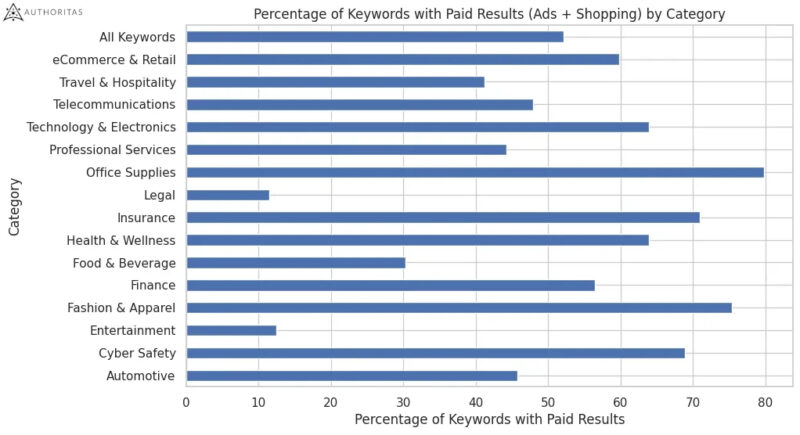
Shopping Ads, meanwhile, appear below SGE 64% of the time, on average.
About the Analysis. It looked at 2,900 keywords for 251 prominent U.S. brands across 15 industry verticals. You can read it here: SGE Research Study – The Impact of Google Search Generative Experience on Brand and Product Terms
Dig deeper:
- Google SGE testing and development is ongoing, growing
- 94% of Google SGE links are different from organic search results, study finds
- Google SGE impact by industry and emerging features
- New Google SGE insights: Content formats, YMYL, product views
- How Search Generative Experience works and why retrieval-augmented generation is our future
- Preparing for Google SGE: Essential guide for marketers
- How Google SGE will impact your traffic – and 3 SGE recovery case studies
- Google patent describes how the Search Generative Experience works
from Search Engine Land https://ift.tt/kBQuIbl
via https://ift.tt/lK3wgxt https://ift.tt/kBQuIbl
Thursday, March 21, 2024
Turbulence ahead: The wrath of the March 2024 core update is not linear
SEOs are already speculating about which update did what to which sites (the March 2024 core update or March 2024 spam update) and what sites should or shouldn’t be doing.
This is a bit dangerous.
Meanwhile, Google is urging SEOs to be patient and to let this thing play out. Google isn’t yanking your chain. There is a ton of volatility and a ton of reversals happening at the moment.
While what I’m about to share is purely anecdotal, I’ve been diving into the nitty gritty of these updates for a while now.
Here’s what I’m seeing. Hopefully, it will help give the March 2024 core update a bit of context as we wait this thing out.
March 2024 core update catch-up
Google said the March 2024 Update is going to be prolonged and that there will be “more fluctuations in rankings than with a regular core update.”
The first big spike in rank volatility was picked up on March 9. Since then there have thus far been two additional peaks, on March 15 and 19.
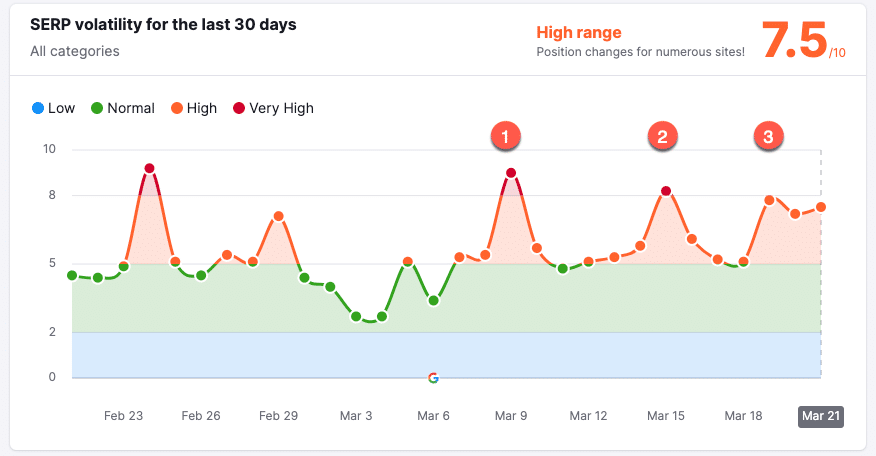
However, that doesn’t mean that with each “sub-spike” comes a “fresh set” of ranking movements. It’s not only very common but basically the rule that the secondary spikes within a core update will present an extensive set of reversals to the rank changes initiated at the forefront of the update.
How many times have you seen a site “win” at the start of the update only to get clobbered towards the end of it?
With the March 2024 core update, you’re going to most likely see various sets of reversals as the update is both longer and more complex than usual.
An absolute heap of rank reversals
No, not every bit of the rank volatility we’re seeing with the March 2024 core update is a reversal. Sites are going up and sites are going. Some of those rank trajectories will ultimately reverse themselves and some of them will stick.
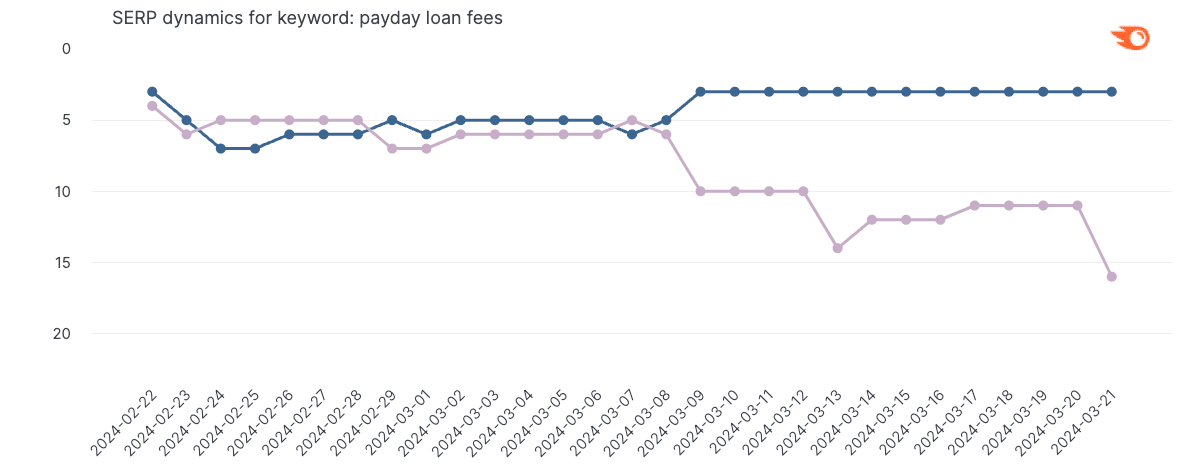
In the above, the most recent “sub-spike” in volatility further didn’t reverse anything, it accentuated the URL’s initial ranking loss.
Caveats aside, there has been a noticeable amount of reversals with the sub-spikes in fluctuations seen on March 15 and 19.
Here’s a case of Allstate losing rank for the keyword free car insurance. When I saw the initial hit in rank the domain took on March 9 for the keyword it was, obviously, surprising.
Lo and behold, there was a bounce back on March 19 followed by a loss on March 20 only to see yet another bounce back on March 21.
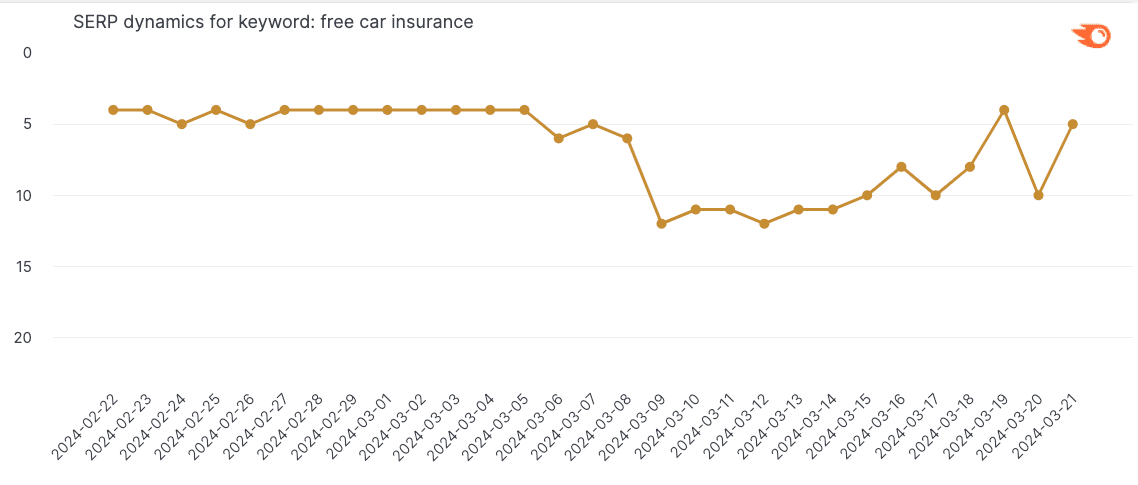
Here’s mousesavers.com showing a pre-update spike (parenthetically, very common to see sites showing sharp rank changes before an update and then subsequent reversals):
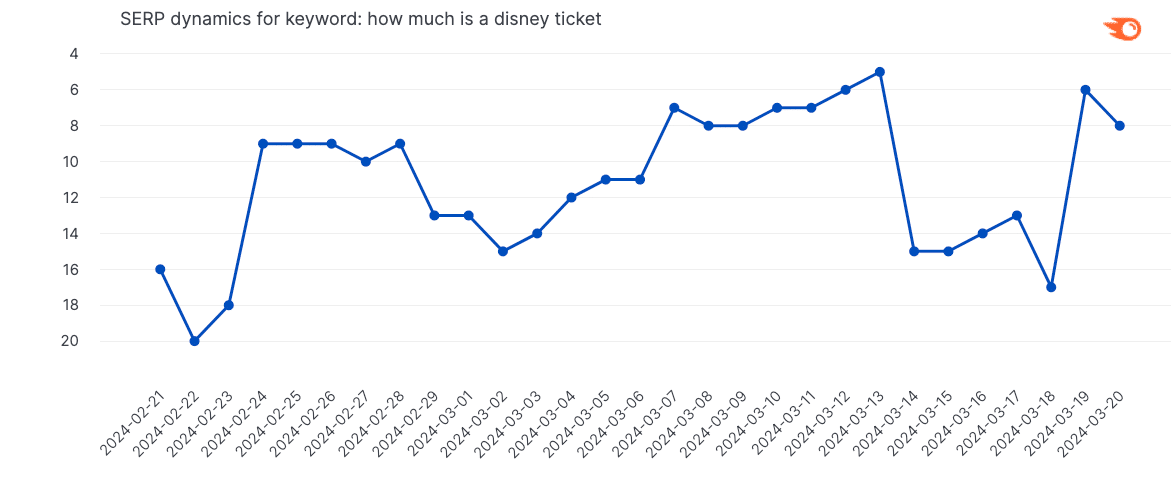
You can clearly see the early volatility spike of the March 2024 core update reverse the pre-update surge. However, just a few days later the downtrend was reversed.
You can see the same pattern play out at the domain level in this case:

As aside, this site sports one of the worst UX’s I’ve seen in a long time. It’s nostalgic in a sick way.
At the same time, it does appear to offer a wealth of information. One could speculate (greatly) that the reversals are a battle between UX and content (or perhaps, they’re just reversals without much deeper meaning at this point).
In the case of the Illinois Department of Public Health’s rankings for the keyword risk factors for oral cancer, the reversals had the site fall completely out of the top 20 for two days:
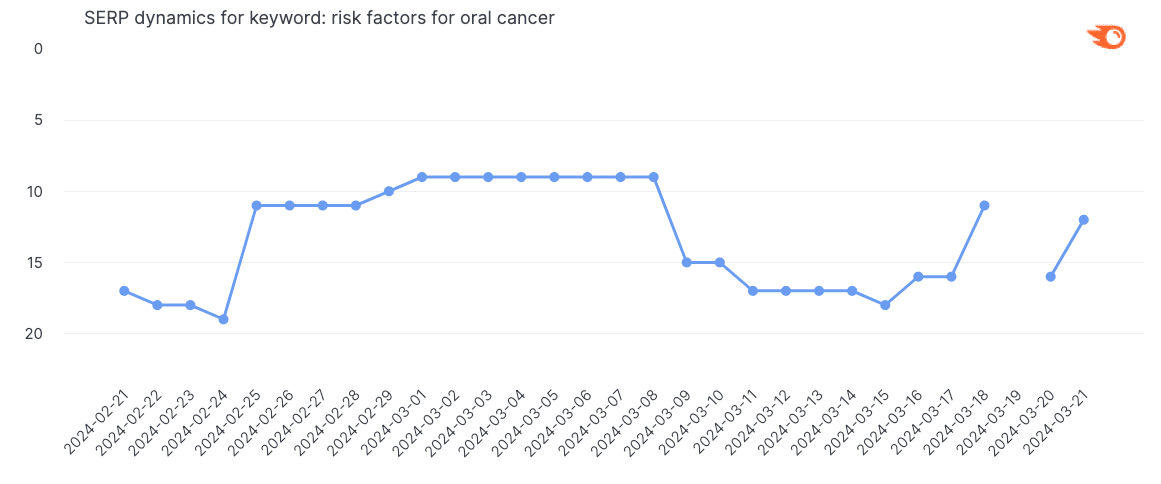
After seeing a reversal on March 18 the site fell out of the top 20 altogether on March 19 and then again on March 21.
For the record, not all reversals are full-on restorations of rank. In the case of this dentistry site, the ranking losses seen at the onset were reversed on March 19 but the site is only halfway back up the SERP relative to its previous rank.
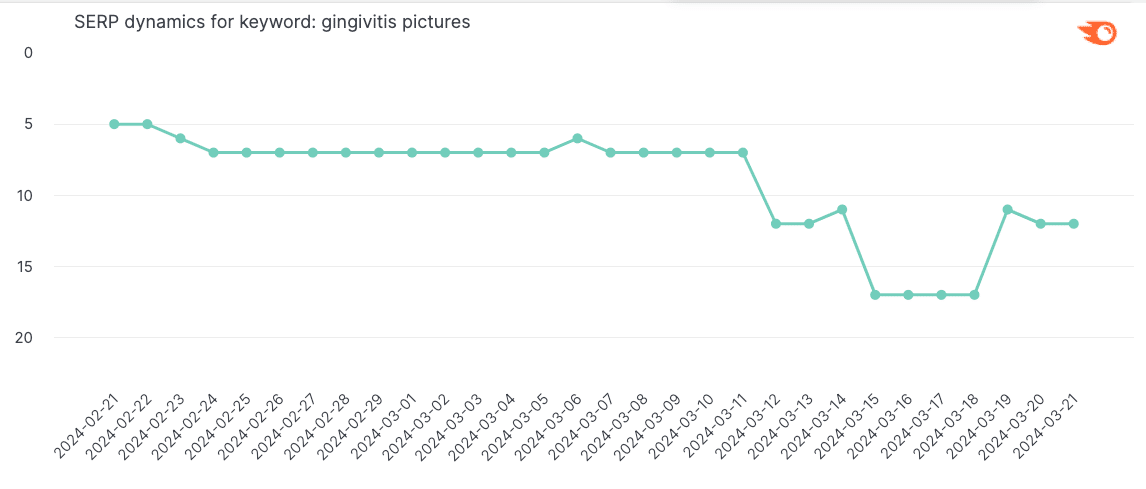
At the domain level, the reversal on March 19 did put it back a bit closer to previous performance:

Same deal for a reversal that causes a ranking loss.
As in the case below, just because the reversal shows a loss doesn’t mean that the ranking loss puts the URL back at square one… yet (or not, who knows at this point!).
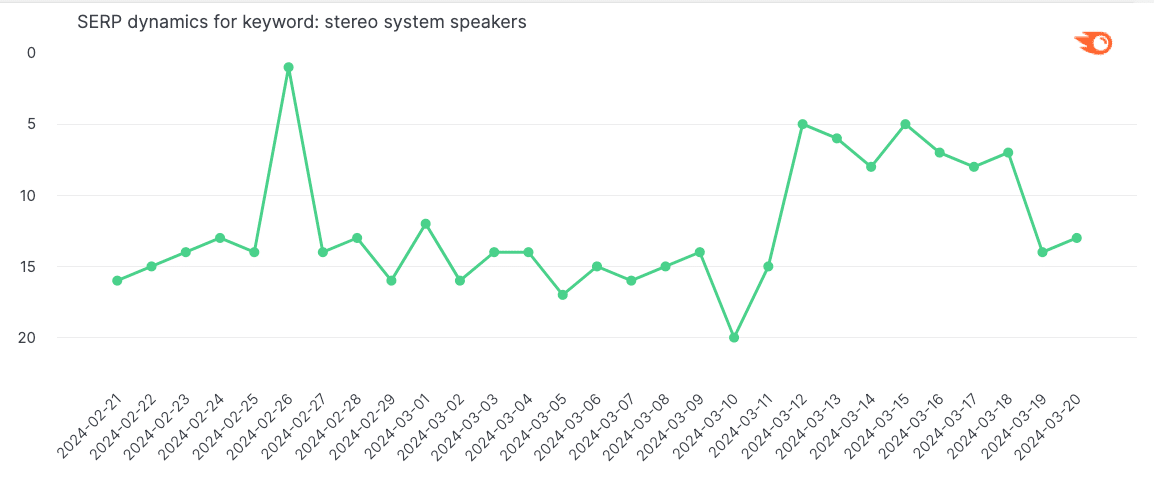
I could go on and on with these cases forever but then my children would have an absent father and no update is more important than your kids (SEO life lesson right there).
Some odd volatility
Aside from the more traditional reversals I’ve seen some just downright weird behavior. It’s entirely pervasive but it’s certainly a more common pattern than in previous core updates (at least that’s what I have seen).
Check this one out:

You might be asking yourself, “What the hell am I looking at?”
You’re looking at Google basically replacing the entire set of results from at least position 20 and up.
A connecting line means a continuation of rank above position 20 from one day to the next.
I only count four such lines within the image above (though, I’ve never been very good at counting).
In fact, you see this pattern take hold over three days. Meaning, Google reshuffled almost the entire SERP not once, not twice, but three times. Many of the URLs ranking on March 18 disappeared on the 19th and some remerged on the 20th.
I’ve seen this before. However, I’ve generally seen it for cases where the SERP is filled with YouTube URLs and Google is shuffling them around day after day after day. This is not such a case.
It’s not a one-off either. I’ve seen this pattern a few times already.
Here’s another similar (if slightly less severe) instance:
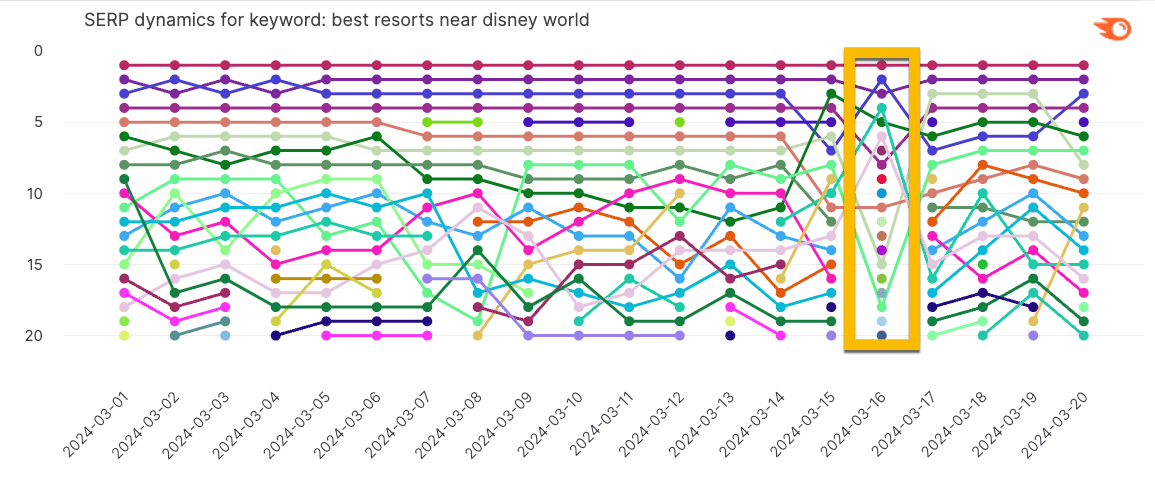
This thing isn’t over – take it slow
What’s my point with all of this?
This is a long and volatile update.
As I said earlier, Google isn’t yanking your chain by saying to remain calm and have patience.
I would assume you’ll see some of the sites and pages I showed here to see numerous more reversals by the time this thing is all said and done.
The same with your or your client’s sites. It’s way too early to try to pin this thing down and have an understanding of where you stand.
So despite me not being that old to actually remember it, this catchy slogan still applies as the March 2024 core update continues to roll, “buckle up for safety, buckle up, always buckle up.”
from Search Engine Land https://ift.tt/QMdwYJH
via https://ift.tt/vSpsJry https://ift.tt/QMdwYJH
Google Analytics 4 addresses Google Ads report discrepancies with conversion update
Google Analytics is shifting from tracking conversions to using “key events” for behavioral analytics, aligning its definition with Google Ads platforms.
This update ensures that what constitutes a conversion will be consistent and easily comparable between Google Ads and GA4 reporting, providing marketers clearer insights into user behavior across platforms.
What’s changing? In GA4, legacy conversions will now be referred to as key events. These events represent crucial actions for behavioral measurement in your business. Additionally, conversions in the report and explore modules will be transitioned to key events, maintaining the same measurement capabilities as the legacy conversion concept. Key events will be considered conversions only when shared with Google Ads, ensuring accurate performance reporting.
Cross-channel reporting. Additionally, the Advertising workspace in GA4 will introduce new cross-channel conversion performance reporting, extending beyond Google Ads. This section will serve as your central hub for monitoring Ads conversion performance, providing comprehensive insights across various advertising channels.
What Google is saying. Kamal Janardhan, Senior Director of Product Management, Measurement, at Google, said in a statement:
- “In this improved, more unified experience, we are addressing the differences in conversions reporting that marketers have experienced across Google Ads and Analytics, a long-standing request that we are happy to have resolved for our customers.”
- “Now, conversions in the existing report and explore modules will become key events. This way you will be able to define the most important customer actions for your business in Analytics and learn what’s working and what’s not to improve your product and experience across websites and apps.”
Why we care. Discrepancies in conversions reporting have long caused headaches for marketers, however, this solution aims to address that issues by ensuring consistency across Analytics and Google Ads platforms. By providing a clearer and more reliable view of conversion data, it helps streamline reporting processes and enhances the accuracy of analysis.
Action needed? Users of GA4 and Google Ads do not need to take any action. Legacy conversions will be automatically converted to key events, while any conversions shared with Google Ads will be labeled as conversions and reported on within the Advertising section.
Deep dive. Read Google’s conversions vs. key events guide for more information.
from Search Engine Land https://ift.tt/3e2KPwR
via https://ift.tt/vSpsJry https://ift.tt/3e2KPwR
'Will Send You To Jail': High Court Warns Delhi Minister Saurabh Bharadwaj
Wednesday, March 20, 2024
Google Marketing Live 2024 registration opens
Google Marketing Live registration is now open.
The conference is Google’s annual event for showcasing its latest ad products, formats, developments, and updates.
When is Google Marketing Live. Tuesday, May 21, starting at 12 p.m. ET / 9 a.m. PT, live from Mountain View, Calif.
How to register. You can register for Google Marketing Live 2024 here. Here’s what Google is teasing:
- “Get a front row seat to see Google’s newest Ads innovations and learn how you can put Google AI to work for your business. Watch the live keynote and access on-demand sessions to see how to drive next-level growth for your business.”
Why we care. Google Marketing Live is where Google typically announces a slew of new products and features. Google Marketing Live 2023 was heavy on AI announcements.
from Search Engine Land https://ift.tt/enySM8O
via https://ift.tt/GzxMhRH https://ift.tt/enySM8O
Tuesday, March 19, 2024
On Camera, Bengaluru Metro Staff Masturbates In Front Of Woman Passenger
On Camera, Boy Slips From Father's Arms, Falls To Death In Raipur Mall
4 Killed After Vehicle Carrying Tourists Falls Into Gorge In Kerala: Cops
Monday, March 18, 2024
SEO planning: Your one-page SEO plan
This article will show you how to create a simple SEO plan.
This plan focuses on a single group of related keywords applicable to your business’s primary offerings or individual products/services. The plan is concise and fits onto a single page.
SEO planning vs. SEO strategy
SEO planning is often conflated with SEO strategy. Although they are related, they are different parts of your overall SEO process, so they should be considered separately.
SEO strategy involves identifying an SEO USP and finding a way to stand out from the crowd (I detail how to do that here).
SEO planning is the tactical process of delivering your strategy.
The objective is to take the complexity out of the planning so you can focus on the SEO (which is complicated enough).
What is an SEO plan?
An SEO plan covers how to research, document, create, optimize and promote content to improve your website’s visibility on search engines. It will help you attract visitors and generate more business from your website.
The plan you will create here is a highly simplified approach that anyone can follow and will help you get started with SEO.
The steps we will follow here are:
- Step 1: Create a list of related keywords
- Step 2: Identify search intent
- Step 3: Strategize
- Step 4: Create
- Step 5: Optimize
- Step 6: Promote
You will detail this in our simple One-Page SEO Plan template. (It is a Google Doc, so navigate to File > Make a Copy to create an editable version.)
This plan is purposely simple to keep you focused on what matters. There is no talk of web design, technical SEO, generative AI or other fancy bells and whistles. Instead, this plan is simple and focused on what matters — creating great content that Google loves and ranks highly.
Step 1: Create a list of keywords
Our goal here is to identify a list of related keywords.
We want to optimize your homepage, a product, service or content, so all search terms should relate to this single item.
This should give us several keywords with the same overall intent behind them.
We then want to form these keywords into an organized group.
There are a few approaches you can use here:
Talk it through
I suggest talking this through with your team. Make a note of all the search terms you can think of. If your team has customer-facing members, they will likely have some powerful insights.
Google autocomplete
Take your initial list and Google those terms. Google autocomplete will give you loads of suggestions in the drop-down box.
A simple tactic I like is to add your main term and then work through the letters of the alphabet and see how it alters the suggestions. For example:
- SEO a…
- SEO b…
- SEO c…
- Etc.
Pull the trigger on relevant terms and get more related searches at the bottom of the page.
Google Search Console
If you already have a website, you can look at the search terms you already rank for.
You can filter this to look at the terms that relate to a single page and get a list together that Google already agrees with, and you are at least part of the way there.
SEO tools
Various SEO tools can help you flesh out your list of keywords and get some search volume and difficulty. I would start with the Keyword Planner in Google Ads.
Action items
Make notes in your one-page SEO plan template.
You aim to find five to 10 related keywords that work from shorter and more specific to longer tail keywords.
Get these in a spreadsheet with search volume and relative difficulty (you can use PPC difficulty as a gauge if you don’t have a paid SEO tool). For example:
- Artificial grass
- Artificial lawn
- Best artificial grass
- Artificial grass near me
Note: If you find a keyword that goes beyond the context of what you are currently looking at, expanding on the example above(e.g., best artificial grass for dogs), then you would create a new one-page SEO plan for that term.
Step 2: Identify search intent
It is easy to see a keyword and the numbers behind it and be tempted to dive in, but more intelligence is needed here to refine your approach.
Firstly, you want to understand the search intent and how the content returned is categorized:
- Are the results helpful and informative?
- Are the results more commercial in nature (products and services)
Answering this question will help you understand what users are looking for, as Google has already run that experiment and tilted the content toward what users are looking for.
Then, what types of content are returned?
Often, you will find that most of the results will be of a given format (like video dominating the top of the page).
Other times, various content types will indicate variability in the searcher’s preferred answer to that question.
For example, I recently had to do some DIY on our tumble dryer to fix a broken button. When searching for solutions, the search results were nearly all videos. By following these videos, I could easily follow along and fix the button (a big win for me as I am not a DIY kind of guy).
Details matter
When it comes to intent, the details matter.
You can’t just look at the posts and say okay, these are informational articles. You need to dig a bit deeper than that.
The results will typically represent the content you should create to rank for this term.
You want to know what they are, how they are similar, what they link to and reference and start thinking about any gaps or opportunities.
Action items
Make notes in your one-page SEO plan template detailing:
- Informational or commercial intent.
- Types of content (videos, blogs, etc.).
- Specifics:
- List-type articles.
- Short actionable tips.
- Maximum 10 tips.
Step 3: Strategize
A common mistake in SEO is creating yet another version of what is already out there. This may have worked in the past to a degree, but it could have been a stronger strategy.
The trick here is to examine the existing results, conduct an SEO SWOT analysis and identify improvements.
A common idea is that what you create should be different or better.
If you are targeting better, try to add something new and unique that makes the content better than what already exists. If you are a contender looking to run with the big hitters, then you have to create something wildly better than what is out there.
Often, being different is easier and better. If the competition is all very similar, being different will help you stand out and piggyback on some of the more established competition.
Another useful job here is to see what is out there and see what people are linking to. This could be statistics, guides, checklists, studies, data or anything else – but there will typically be a pattern.
You have two jobs here. The first is understanding the commonalities between what is out there so you can stand out. The second is to understand what the competing content is linking to so you can be more like that (as this will help with the promotion of the post).
In a previous article, I covered a range of SEO strategies to help you create unique, helpful content that blows your competition out of the water.
Action items
Make notes in your one-page SEO plan template detailing:
- Gaps and opportunities.
- What are people linking to.
- SEO strategy:
- Original research.
- New statistics.
- Checklists, worksheets or something actionable.
Step 4: Create
By this point, you should:
- Understand what is out there.
- Have a strategy to bring something new, different or better to the table.
Now, you just have to build it and they will come.
The specifics here will vary, but if you are a local plumber, it may be as simple as providing a gallery of recent work, case studies or testimonials.
If you are targeting a highly competitive search term, you may need to provide something unique, which may require a study or additional research.
The specifics of different and better will vary depending on the keyword and location but you can’t skimp here, or SEO is not the game you should be playing.
Action items
Make notes in your one-page SEO plan template detailing:
- Document what you will create.
- Create a rough outline of the content (bullet points are enough).
- Detail any images, videos or other assets needed.
Step 5: Optimize
Here, you should note everything you will optimize on the page to follow your plan and check things off the list.
On-page optimization
This is not rocket science, but a checklist will ensure you tick all the important boxes.
- Page title.
- Headers.
- File names and alt text.
- Keywords in the opening paragraph.
- Keywords in body
On-page SEO will vary depending on the topic and format of the article. While important, think of it as the icing on the cake rather than the driving force. Your optimization should be almost invisible to a standard reader!
Action items
Make notes in your one-page SEO plan template detailing:
- Make a list of all of your optimized on-page elements.
- Detail how many times you will use your keywords.
- List all articles where you can link to your new content.
Step 6: Promote
To help your content lift off, you need to promote it. There is a social media aspect and an SEO and PPC conversation, which you should not ignore, but you must build links to see the content fly in the organic search results.
The two main types of links here to consider are:
- Internal links. Review your site and list all places to include an internal anchor text link to your new blog post. CMS systems like WordPress will do some of this by default, but you want to list all the relevant content pieces on your site where you can link to (think promote) this content.
Dig deeper: Internal link building for an E-E-A-T-focused content strategy
- External links. Good external links, not the kind you can buy for $50 bucks from link vendors, but real links from real bloggers, are still crucial, especially for highly competitive keywords. We don’t have to overcomplicate this. Links help Google understand that your content is worthy!
This is where the importance of your strategy and the overall planning comes full circle. People don’t just link to anything for the sake of it.
You must offer something new that ideally adds value to other people’s articles (statistics are big in this industry) so they will want to cite and link to your work.
There are two tactics that I find helpful:
- Google prospecting
- Here you simply Google the terms you want to rank for and find other articles that are out there where your article (or something from it, like a statistic) will add additional value.
- You can then contact these site owners, by the contact form, their email or LinkedIn is often easier and see if you can build a relationship with them that results in a link.
- I always like to try to add some value here and offer a unique comment, some other insight, etc., to make their life easier. You will have more hits than misses.
- Reverse engineering
- Any SEO tool will allow you to see who links to any high-ranking piece of content. By using a tool, you can get a list of the linking domains. Then, as with the prospecting, you can create a pitch and reach out to the site owners.
The link building tipping point
The aim is to get this manually to a position where the article ranks and has a good enough hook to generate links automatically. Remember, to do this, you have to feature something inherently linkable like statistics.
For a comprehensive review of link building today, I recommend reading “Modern link building starter guide” by fellow Search Engine Land contributor Kevin Rowe.
Action items
Make notes in your one-page SEO plan template to:
- List all articles and pages on your site where you can link to your new content.
- Identify a list of external sites for outreach.
Measuring your results
As a final point, you need to measure your results. Beyond this planning for the SEO itself, I would also ensure you define your SEO goals (ideally following the “SMART” framework) and establish a list of SEO measurements or KPIs to ensure your results align with real-world business results.
Failing to plan is planning to fail
SEO can be a complex topic. SEO for even a single site can be incredibly broad. To succeed, like any professional, you need a plan.
This approach steps away from all of the technical aspects of SEO. It simplifies the planning of a single article so you can cover the strategy and execution of a highly-ranked article in a competitive niche.
from Search Engine Land https://ift.tt/B6FE8i5
via https://ift.tt/S1XmQ4O https://ift.tt/B6FE8i5